Over the past forty years, Barefoot College has developed an organic rural education and development model which offers the hope of breaking the obstinate cycle of rural illiteracy, apathy and poverty which has sentenced over 600 million residents of village India — and several multiples of that number in developing nations of the third world — to lives of perpetual want, hopelessness and despair. Dilip Thakore reports
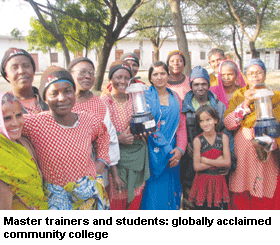 In the context of post-independence India’s patchy national development effort, the newly constructed, straight as an arrow, four-lane National Highway No. 8 which links Jaipur, the capital of the western India desert state of Rajasthan (pop.69 million), with New Delhi via Ajmer, is a marvel of engineering. It takes a taxi a mere 80 minutes to zip down the highway to Patan, a small town and point of departure into the scrub and gravel roads of rural India, one of which leads to the village of Tilonia (pop.4,000).
In the context of post-independence India’s patchy national development effort, the newly constructed, straight as an arrow, four-lane National Highway No. 8 which links Jaipur, the capital of the western India desert state of Rajasthan (pop.69 million), with New Delhi via Ajmer, is a marvel of engineering. It takes a taxi a mere 80 minutes to zip down the highway to Patan, a small town and point of departure into the scrub and gravel roads of rural India, one of which leads to the village of Tilonia (pop.4,000).
Yet during the past four decades since the Social Work and Research Centre (SWRC) was modestly promoted in Tilonia, by the then 25-year-old Sanjit (‘Bunker’) Roy in 1972, this road less traveled has been traversed by a continuously rising number of famous development scientists and thinkers including former World Bank president Robert McNamara, and most recently the Dalai Lama. Over the past 40 years, SWRC has transformed into the globally acclaimed Barefoot College — perhaps the only village-based community college worldwide — whose organic rural education and development model offers the hope of breaking the obstinate cycle of rural illiteracy, apathy and poverty which has sentenced over 600 million residents of village India — and several multiples of that number in developing nations of the third world — to lives of perpetual want, hopelessness and despair.
In essence, Barefoot College (BC) — a self-selected appellation of the original promoter-drivers of the college, which included Roy (an alumnus of the renowned Doon School and St. Stephen’s College, Delhi), his wife Aruna (IAS) and three alumnae of the Tata Institute of Social Sciences (Manya Jayaram, Yogavalli Rao and Shukla Kanungo), who initiated the college’s preventive health and informal education programmes — is a full scholarship vocational training institution which has adopted and revived rural India’s discarded peer-to-peer learning model with great success. Today, 40 years after commencing its hesitant operations, BC is not only a model rural community college engaged in transforming illiterate villagers of both sexes into solar energy generating and rainwater harvesting engineers and educators, it’s also the rural development hub of 200 villages in the Ajmer and Jaipur districts of Rajasthan with substantially higher human development indices and standards of living than the country’s much neglected stone-age villages.
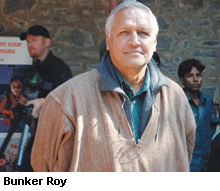 “BC is the only college worldwide which consciously follows the teaching, life and work style of Mahatma Gandhi, who envisioned an India comprising thousands of self-sustaining village republics. Here we don’t accept that village farmers, artisans and service providers are uneducated even if they are illiterate. On the contrary, we believe most village folk are well educated having inherited traditions of crafts, water management, weather forecasting and agriculture knowhow and survival which are thousands of years old. In BC, our objective has been to revisit education by reviving the native skills of village India to tangibly improve people’s lives by enabling them to generate solar energy, manage water resources and build capacity for sustained development,” Roy informed your correspondent, who visited the college in early January to briefly experience the transformative Gandhian socio-economic experiment of this extraordinary teaching-learning instit-ution — the “only college built by the poor, for the poor and for the past 40 years managed, controlled and owned by the poor” (see interview).
“BC is the only college worldwide which consciously follows the teaching, life and work style of Mahatma Gandhi, who envisioned an India comprising thousands of self-sustaining village republics. Here we don’t accept that village farmers, artisans and service providers are uneducated even if they are illiterate. On the contrary, we believe most village folk are well educated having inherited traditions of crafts, water management, weather forecasting and agriculture knowhow and survival which are thousands of years old. In BC, our objective has been to revisit education by reviving the native skills of village India to tangibly improve people’s lives by enabling them to generate solar energy, manage water resources and build capacity for sustained development,” Roy informed your correspondent, who visited the college in early January to briefly experience the transformative Gandhian socio-economic experiment of this extraordinary teaching-learning instit-ution — the “only college built by the poor, for the poor and for the past 40 years managed, controlled and owned by the poor” (see interview).
Eye-pleasingly landscaped across eight acres, Barefoot College was constructed over three years (1986-89) from a rough architect’s blueprint by Bhanwar Jat, an illiterate farmer of Tilonia village, and 12 barefoot architects, who supervised the work of 50 rural masons and 100 day labourers applying traditional construction skills and techniques they had learned from working in their own communities. Built on a barren, sandy patch of land purchased by SWRC in 1980 at a cost of Rs.30,000, the entire new campus comprising 16 buildings with an aggregate built-up area of 100,000 sq.ft is powered by solar energy with over 600 solar panels on every rooftop capturing, storing and disseminating 50 kw of electricity per day. Moreover, a sophisticated system of rainwater harvesting collects and stores 1 million litres of water in several underground tanks including a giant tank with a capacity of 400,000 litres, over which a 1,000-seat open air amphitheatre has been constructed.
In addition the college campus is a training facility which boasts a health centre, dental clinic, solar cookers assembly unit, a fabrication workshop, sanitary napkins manufacturing unit, a computer lab, audio visual films centre, and communications centre including an FM radio station. Served by a solar-powered community kitchen, there are guest rooms for visitors and offices and housing for 35 families residing on the campus.
Meanwhile on the old campus, under a programme funded by the Union ministry of external affairs, illiterate grandmothers from over 28 African and other developing countries are housed for six months and trained to transform into master WBSEs (women barefoot solar engineers) by a faculty of 25 BC-trained master trainers including eight Indian WBSEs. When your corres-pondent visited the old campus — an abandoned British era tuberculosis hospital in which the BC experiment began in 1972 — 200 grandmothers (“they usually have no desire to migrate out of their villages”) from over a dozen countries including Kenya, Tanzania, Mali, Burkina Faso and Peru were undergoing training (see box).
Yet important as the BC campuses are for reviving and showcasing the inherited rural technologies and capabilities developed and passed down over generations in the oral and demonstrative traditions of village India, the college itself is a hub-with-spokes institution. It reaches deep into 200 villages of the Silora and Dudu blocks of Ajmer and Jaipur districts, where solar energy lighting, rainwater harvesting and women’s empowerment initiatives are a reality and 150 night primary schools are operational.
Moreover the spokes of Barefoot College have reached well beyond Rajasthan. To date engineers of 23 replica institutions in 14 states run by BC-trained barefoot professionals grouped under the banner of SAMPDA (Society for Activating, Motivating, and Promoting Devel-opment Alternatives) have installed solar panels and/or portable solar lanterns in 5,200 households in 600 villages across India and in 38 countries around the world. Likewise, the BC-trained network of 3,140 barefoot teachers (mainly unem-ployed rural youth) run 71 crèches and 714 night schools in five states (Assam, Orissa, Uttaranchal, Madhya Pradesh and Bihar) apart from Rajasthan.
Despite the towering personality of Bunker Roy, designated director of SWRC/Barefoot College, the day-to-day management and administration is smoothly conducted in collegiate style by a 22-member council of elders, drawn from rural communities in the neighbourhood of Tilonia and trained in BC. Indeed Roy, who is often out of the country on fundraising expeditions — in 2010-11, 54 percent of the total budget of Rs.17.28 crore of BC was contributed by funding from foreign sources including international aid agencies (UNDP, Unicef, DFID, Oxfam etc), philanthropic foundations and corp-orate and individual donors — takes considerable pride in asserting that the college and its activities run themselves under the guidance and direction of the core council of barefoot managers.
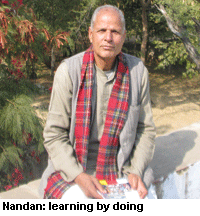 For instance, the operations of BC’s highly successful solar energy unit which has electrified 40,000 homes in 38 countries worldwide and has won this community college global acclaim, are supervised by Bhagwat Nandan — a class X dropout from a government school in Harmada district — who began his career as a BC night school teacher. In 1975 after he underwent a short NCERT (National Council for Educat-ional Research and Training) teacher training course, he was given charge to establish SWRC/BC’s first classes I-V night schools in Tilonia and its neighbouring villages. While doing so, he also devised a primary school and vocational education syllabus “relevant for village India”, which with conti-nuous modifications duly approved by village level parent committees and the BC council, is being followed in over 714 night schools (mainly attended by children working during the day) in five states countrywide. In 1984, Nandan returned to BC as a student and learned the principles of solar energy generation — “all about diodes, solar panel fabrication, storage batteries and circuit assembly fabrication and maintenance” — from a functionally literate village teacher. “I learned easily and thoroughly because I learned by doing,” recalls Nandan.
For instance, the operations of BC’s highly successful solar energy unit which has electrified 40,000 homes in 38 countries worldwide and has won this community college global acclaim, are supervised by Bhagwat Nandan — a class X dropout from a government school in Harmada district — who began his career as a BC night school teacher. In 1975 after he underwent a short NCERT (National Council for Educat-ional Research and Training) teacher training course, he was given charge to establish SWRC/BC’s first classes I-V night schools in Tilonia and its neighbouring villages. While doing so, he also devised a primary school and vocational education syllabus “relevant for village India”, which with conti-nuous modifications duly approved by village level parent committees and the BC council, is being followed in over 714 night schools (mainly attended by children working during the day) in five states countrywide. In 1984, Nandan returned to BC as a student and learned the principles of solar energy generation — “all about diodes, solar panel fabrication, storage batteries and circuit assembly fabrication and maintenance” — from a functionally literate village teacher. “I learned easily and thoroughly because I learned by doing,” recalls Nandan.
The extent to which the barely literate villagers of Ajmer and Jaipur districts have mastered solar energy generation, storage and dissemination technology through peer-to-peer learning-by-doing pedagogies, is explained by Laxman Singh, a rare geology graduate of Rajasthan Univ-ersity. “Currently the solar energy system installed on the new campus at a cost of Rs.1 crore in 1984, provides 50 kw of electricity per day which powers 100 electric fans, 500 lights, 30 computers and 60 intercom connections apart from providing heated water and cooking energy to the 35 families living and working here. Moreover the vital function of maintaining the system is discharged mainly by WBSEs trained to fabricate and assemble circuits — each comprising 40-50 components — right here in Barefoot College,” says Singh with a hint of pride in his voice.
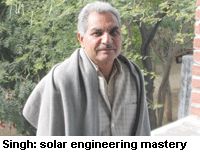 Another focus area of BC is rainwater harvesting (RWH). Again, the new (and old) campus of the college served by sloping roofs, runoffs and elementary piping which channels the region’s meagre monsoon rains into a major 400,000 litre underground water storage tank below the amphitheatre, besides several other subterranean water storage tanks which store 600,000 litres, offers a live demonstration of the technological feasibility of RWH. Ram Karan, another of the rare graduates (M.Com) of Barefoot College who began his association with the college as a 12-year-old providing basic education to women in purdah in 1972, currently organises women’s empowerment and development groups, and supervises the college’s RWH initiatives. He recalls visiting 200 villages of the Ajmer and Jaipur districts in 1986, following an unprecedented 15-year period of scanty rains and drought.
Another focus area of BC is rainwater harvesting (RWH). Again, the new (and old) campus of the college served by sloping roofs, runoffs and elementary piping which channels the region’s meagre monsoon rains into a major 400,000 litre underground water storage tank below the amphitheatre, besides several other subterranean water storage tanks which store 600,000 litres, offers a live demonstration of the technological feasibility of RWH. Ram Karan, another of the rare graduates (M.Com) of Barefoot College who began his association with the college as a 12-year-old providing basic education to women in purdah in 1972, currently organises women’s empowerment and development groups, and supervises the college’s RWH initiatives. He recalls visiting 200 villages of the Ajmer and Jaipur districts in 1986, following an unprecedented 15-year period of scanty rains and drought.
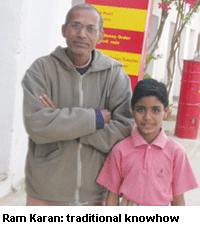 “At the time BC started training women in RWH by establishing a model system in the college. Drawing on traditional village knowhow, we dug wells, cut channels to canalise rainwater into ponds, built anicuts, check dams and learned about contour soil binding. All this was done by drawing on traditional skills, cooperation and knowledge which had been passed down for many centuries, although disparaged by city-trained government engineers. The result of these initiatives, particularly of training women in RWH technologies, is that drinking and potable water shortages in Tilonia and over 200 villages in the neighbouring districts have been eliminated,” says Ram Karan.
“At the time BC started training women in RWH by establishing a model system in the college. Drawing on traditional village knowhow, we dug wells, cut channels to canalise rainwater into ponds, built anicuts, check dams and learned about contour soil binding. All this was done by drawing on traditional skills, cooperation and knowledge which had been passed down for many centuries, although disparaged by city-trained government engineers. The result of these initiatives, particularly of training women in RWH technologies, is that drinking and potable water shortages in Tilonia and over 200 villages in the neighbouring districts have been eliminated,” says Ram Karan.
Although solar energy generation and rainwater harvesting are the prime focus areas of the Barefoot College manag-ement, in the four decades since it was promoted as an alternative education venture, the college has expanded its training operations to cover 14 faculties or fields of rural development activities. Currently they include solar energy, RWH, crèche and primary education, women’s empowerment, recycled waste, fabrication workshops, solar cooking and water heating units, health services including a dental clinic and water testing centre. And it is the unwritten human resource development policy of the college to rotate all managers within the faculties to ensure they are familiar with and can manage all BC activities.
For instance, Ram Niwas, a Dalit who began his career as an adult literacy government teacher after completing higher secondary school, signed up as an accounts division clerk. Soon after, he was deployed as a teacher in the college’s night schools and simultan-eously learned the art of communication through puppetry in the college. Currently Ram Nivas supervises the operations of BC’s six-member communications division which stages puppet shows with social and political messages before village assemblies; has established district level Children’s Parliaments, runs an FM radio station which broadcasts information relating to government welfare and development schemes such as RTI and NREGA, and conducts interviews with postmasters, bank managers and other public officials.
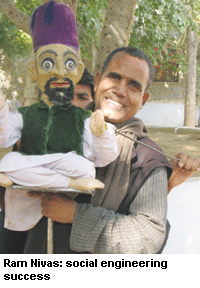 “Casteism, communalism and gender prejudice have been completely eliminated on the college campus. Moreover through the activities of our communications section, we have been fairly successful in creating a similar mindset change in over 200 villages in our neighbourhood. Over a period of time, the college has not only infused confidence and raised standards of living in villages in Rajasthan and several other states, but also played a major role in eliminating the evils of caste, religious and gender discri-mination, which have severely hindered development in rural India,” says Ram Nivas.
“Casteism, communalism and gender prejudice have been completely eliminated on the college campus. Moreover through the activities of our communications section, we have been fairly successful in creating a similar mindset change in over 200 villages in our neighbourhood. Over a period of time, the college has not only infused confidence and raised standards of living in villages in Rajasthan and several other states, but also played a major role in eliminating the evils of caste, religious and gender discri-mination, which have severely hindered development in rural India,” says Ram Nivas.
But though BC’s most spectacular successes have been in vocational education, its sustained efforts in preschool and primary education which is an integral component of its unique uncertified education package, and has sparked a rural development revolution (almost completely ignored by mainstream media), have been no less successful. Currently, BC’s 714 primary night schools in 673 villages in Rajasthan and five states across the country, boast an aggregate enrolment of 235,000 children instructed by 3,140 teachers trained in Barefoot College, Tilonia.
Uniquely, the curriculum of each school is co-operatively designed by village committees, a children’s parliament, and teachers as per local requirements and priorities. “Formal syllabuses and curriculums followed in urban schools are inappropriate for village India. We believe basic primary education which makes children literate and numerate, plus vocational educ-ation appropriate for local conditions is the best prescription for improving socio-economic conditions in rural India,” says Teja Ram, a commerce graduate of Rajasthan University who began teaching in a BC night school in 1983, and as a member of the college’s core committee supervises the accounts and night schools division of SWRC.
 Core committee members take justifiable pride that BC and the communities it has touched have substantially attained the United Nations’ Millennium Development Goals set by the Millennium Declaration signed by representatives of 189 countries in the year 2000 (see box). Yet perhaps the most significant impact the college has made is changing the national mindset about gender equality. In the two BC campuses as also in the night schools and villages neighbouring the college, there is visible gender egalitarianism, in sharp contrast to the norm in rural India. Indeed Bunker Roy and most core committee members profess a bias in favour of investing institutional time and resources in women engineers, teachers, artisans and maintenance personnel on the reasoning that women tend to be more committed to home and hearth in rural India than men, who favour migration to the country’s crumbling cities where they add numbers to insanitary slum settlements.
Core committee members take justifiable pride that BC and the communities it has touched have substantially attained the United Nations’ Millennium Development Goals set by the Millennium Declaration signed by representatives of 189 countries in the year 2000 (see box). Yet perhaps the most significant impact the college has made is changing the national mindset about gender equality. In the two BC campuses as also in the night schools and villages neighbouring the college, there is visible gender egalitarianism, in sharp contrast to the norm in rural India. Indeed Bunker Roy and most core committee members profess a bias in favour of investing institutional time and resources in women engineers, teachers, artisans and maintenance personnel on the reasoning that women tend to be more committed to home and hearth in rural India than men, who favour migration to the country’s crumbling cities where they add numbers to insanitary slum settlements.
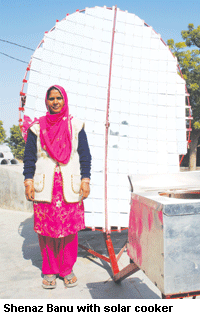 The degree to which illiterate village women have been emancipated by BC’s unique education model was strongly impacted upon your correspondent while visiting the college campus. Shenaz Banu is a middle-aged housewife who supervises the operations of the solar cooker and water heater fabri-cation unit which manufactures giant solar heaters with discarded metal parts including a bicycle chain, recycled stove wheel and bits and pieces of ordinary mirror glass supported by a metal frame and clockwork arrangement, which turns the 15-20-ft-high invention to follow the sun. She could barely conceal her impatience and dismay when your correspondent was slow to grasp the modus operandi of the solar power-driven cooker. “This machine costs a mere Rs.15,000 and can be assembled on site in village locations by our engineers within a day,” she said, demonstrating the solar heater’s properties by heating a kettle and serving a cup of tea within five minutes. Shenaz Banu learned the fabrication technology within one month from Wolfgang Seppler, a German engineer who was visiting faculty at BC in 2003.
The degree to which illiterate village women have been emancipated by BC’s unique education model was strongly impacted upon your correspondent while visiting the college campus. Shenaz Banu is a middle-aged housewife who supervises the operations of the solar cooker and water heater fabri-cation unit which manufactures giant solar heaters with discarded metal parts including a bicycle chain, recycled stove wheel and bits and pieces of ordinary mirror glass supported by a metal frame and clockwork arrangement, which turns the 15-20-ft-high invention to follow the sun. She could barely conceal her impatience and dismay when your correspondent was slow to grasp the modus operandi of the solar power-driven cooker. “This machine costs a mere Rs.15,000 and can be assembled on site in village locations by our engineers within a day,” she said, demonstrating the solar heater’s properties by heating a kettle and serving a cup of tea within five minutes. Shenaz Banu learned the fabrication technology within one month from Wolfgang Seppler, a German engineer who was visiting faculty at BC in 2003.
Young Bata Bhurji, a sociology and history graduate of Rajasthan University, who supervises the operations of BC’s audio visuals, films and communi-cations unit, exudes similar confidence and commitment. “In June 2004 when I was a volunteer with MKSS (a rural workers’ union registered by Aruna Roy), my father who was working in BC passed away in a road accident together with six people from the college. Mr. Roy invited me to carry on my father’s work and it was a turning point in my life. I have been working and learning in this great organisation where everybody works for the development and upliftment of rural communities. In the process, I have developed a great emotional attachment with our local communities, especially with our night school children. BC has given the rural poor self-esteem, motivation to live with dignity, and connected them to the world,” says Bhurji.
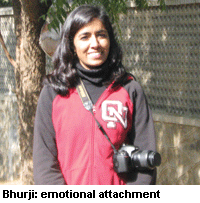 But although 40 years since it began as a modest rural development venture on its old campus in Tilonia, Barefoot College has devised a formula for the revival of India’s failed rural develop-ment effort, true to the biblical lament that a prophet is not without honour save in his own country, the trail-blazing track record of this rural community college is more celebrated abroad than in India. On the contrary, the BC policy of deliberately empowering the Dalit and OBCs (other backward castes) by focusing its primary and vocational education initiatives upon them and women in particular, has upset traditionally powerful rural elites as well as the education establishment who have a vested interest in the status quo.
But although 40 years since it began as a modest rural development venture on its old campus in Tilonia, Barefoot College has devised a formula for the revival of India’s failed rural develop-ment effort, true to the biblical lament that a prophet is not without honour save in his own country, the trail-blazing track record of this rural community college is more celebrated abroad than in India. On the contrary, the BC policy of deliberately empowering the Dalit and OBCs (other backward castes) by focusing its primary and vocational education initiatives upon them and women in particular, has upset traditionally powerful rural elites as well as the education establishment who have a vested interest in the status quo.
Comments Jesse Hartigan who served as visiting faculty at BC in 2007, writing for Innovations — Technology, Governance and Globalisation, a journal of the Massachusetts Institute of Technology, USA: “Those most hostile to the Barefoot approach are people who have invested a great deal in acquiring an education through the official system and then applying their misguided ‘expertise’. The very idea of semi-literate women being able to manage and control initiatives at the village level undermines those hard-earned credentials and credibility and even threatens the existence of their jobs. Indeed one result of the Barefoot approach in India where it is most widely replicated, has been replacement of cost-intensive initiatives by low-cost and labour intensive initiatives, providing gainful employment within the villages.” (Innovations, Spring 2008 mitpress.mit.edu/innovations).
Operating within the larger disabling environment dominated by contem-porary India’s 18 million-strong neta-babu (politician-bureaucrat) kleptocracy which has much to lose by way of political power, economic rents, speed money and other illegal imposts routinely extracted from the citizenry, the BC management is obliged to maintain a low public profile despite the patent success of its village education and development model. The college receives a grant of over Rs.2.5 crore per year from the Union government — mainly for the purpose of importing grandmothers from around the world to the BC campus to be trained as WBSEs — and is dependent upon the state government for law and order, road networks and other essential services.
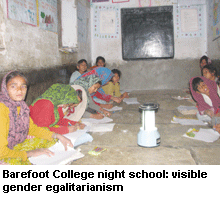 Nevertheless, for Bunker Roy it’s “extremely satisfying” that from its first tentative steps as a rural night school, Barefoot College has developed a robust rural education and development model which has infused “confidence, competence and belief” in the people of over 200 villages in Rajasthan and 13 states across the country.
Nevertheless, for Bunker Roy it’s “extremely satisfying” that from its first tentative steps as a rural night school, Barefoot College has developed a robust rural education and development model which has infused “confidence, competence and belief” in the people of over 200 villages in Rajasthan and 13 states across the country.
“We are steadily building the capacity and competence of village India to help itself. Over the past thousands of years, rural artisans, engineers, architects and other professionals have developed and inherited valuable skills and compet-encies which need to be revived and encouraged. The Barefoot College is essentially a laboratory which looks deep into the history and cultures of traditional societies to develop appro-priate solutions to improve the quality of life in India’s villages. These solutions are available to anyone to pick up, modify, improve if necessary, and implement. In BC our major achievement is that we have demystified and decentralised rural development and have given local communities the confidence to rely on their traditional technologies and wisdom to rise out of poverty,” says Roy.
It’s an overdue denouement that all right-thinking members of society will unreservedly welcome.